Listen: Maria Douza Shows Us How
By Diane Sippl
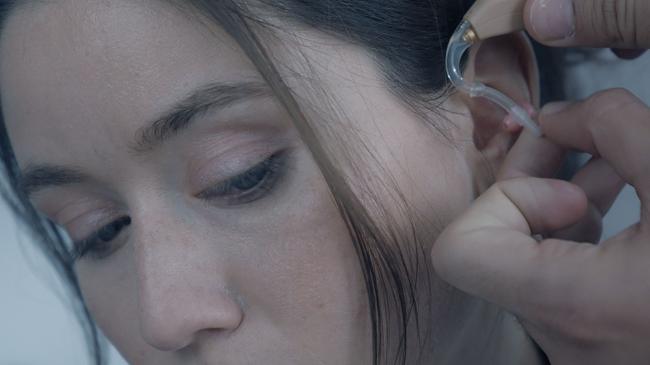
Is it our ears—or our emotions—that are the gatekeepers of sound?
“Are you listening?” How many times have we voiced that question, when clearly the other person is hearing? Some people are plugged-in (with or without headphones) to their own narrow circuits, detached from inter-personal or broader social communication; others are so attention-deficit that they can’t focus enough even to be selectively tuned-in to another’s attempt at expression. But what about someone who is not hearing, due to either a physical impairment or a willful disconnect—the refusal to read another’s sign language or to attach an auditory device?
Does it matter, then, the difference between hearing and listening?
Put another way, a recent cartoon by SIPRESS in The New Yorker magazine shows a man sitting in a waiting room where a woman returns to it, telling him, “The doctor says my hearing’s fine, but he wants to check out your mumble.”
Maria Douza’s second feature film, Listen, is to be celebrated as the Closing Night Gala screening at the 17th Los Angeles Greek Film Festival on June 11, 2023 at 5:00 pm at the Pacific Design Center’s Silver Screen, where she and her young protagonists, Efthalia Papakosta and Dimitris Kitsos (cast as Valmira and Aris) will join the festival. Listen poignantly plays out the differences—and similarities—between aural (hearing) and oral (speaking) aspects of language, culture, and cinema. More specifically, we discover the vital difference between “hearing” and “listening.” Communication, as we know (and often forget, sloppily or willfully), is a two-way process. It’s an active commitment that holds together the couple, the family, the society—even the self. While focusing on a teenage girl who is deaf due to a childhood illness, Listen is all about a group of people—a school, a neighborhood, a culture—and those who can, do, and don’t listen, by choice and by default, and who learn to take stock of what they do and don’t say, whether in words or any other language.
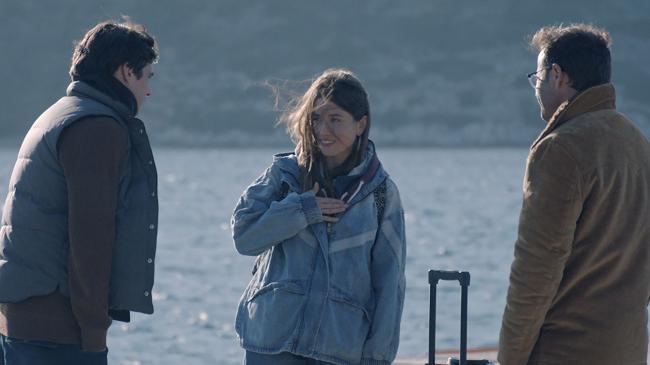
Maria Douza studied Byzantine Literature in Athens and Film Direction at the National Film and Television School of England. In 2008, she joined production company Steficon as in-house Film Director, making cultural videos, commercials, and documentaries for television and the web. In 2013, she wrote and directed her first feature, The Tree and the Swing (aka A Place Called Home); it represented Greece in many European Union Film Festivals (Chicago, Toronto, Beijing, Shanghai, Hong Kong, India etc.) and gained both domestic and international distribution as well as purchase by NETFLIX. She then made “Thission Cinema of Athens” (2017, 52’), a drama-documentary about an emblematic open-air cinema in Athens, for the French Canal+ series, Mythical Cinemas shown all over the world; “In the Writer’s Workshop (2018, 63’), a documentary on Pantelis Kaliotsos; and “Liberation” (2020, 15’), a short documentary on the wildlife preservation organization ANIMA. In 2020, she created the extremely popular World History 54 television series, “Small Lessons on a Big World,” running from 2020-2022, directing 22 episodes. ERT-WORLD will broadcast the series worldwide.
In Listen, financial upheaval leads Stamos to uproot his daughter, 16-year-old Valmira, from her prestigious School for the Deaf in Athens, where her grandmother has been raising her, to an Aegean island where she will live with him, his new partner from Bulgaria, Tania, and her son, 18-year-old Aris. At his school, Aris is bullied by classmates, including the xenophobic Marios, so Valmira alienates herself from Aris, Tania, and Stamos, who has promised to return her to Athens one day soon. One way of isolating herself from her new family is her refusal to wear the hearing aid she was given upon her departure from the mainland.
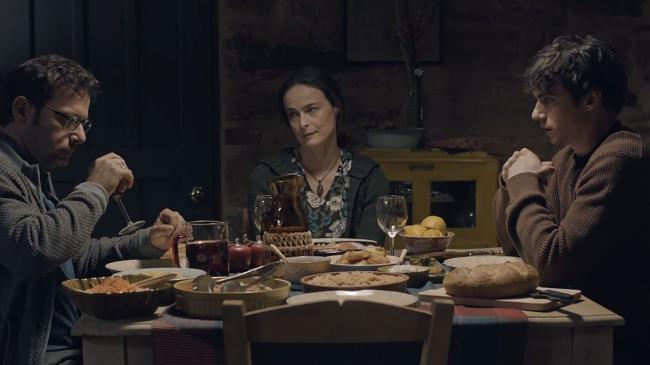
KINOCaviar Valmira’s father “transplants” her to his home village from long ago. Where is the island, and how do we know? It seems to matter because Listen deliberately offers a mix of national cultures in its characters. Who is Greek and who is Bulgarian? Why do the schoolboys refer to Aris as Albanian? Is it because Albanians (not the more recent Syrians or Africans) are the most marginalized where these boys live, so it’s the most direct way of harassing Aris?
Maria Douza The island is Chios, but it does not matter, because what happens there is representative of what could happen in any small place, whether in Greece or elsewhere in the world. Our world is changing; it’s becoming mixed ethnically and culturally, and this is not specific to one place, but it is challenging for all, and even more for small places. Small communities tend to be reserved and suspicious and even intolerant towards the “other,” be that person a foreigner or somebody different. This is the context of the story.
Of course every place and every country has its own particularities. So, though it does not matter which island it is, for the sake of realism we use the cultural elements of Chios (music and dance). What matters more is the idea of the island, which is a metaphor for isolation—and part of the film’s thematic development.
The reason kids call Aris Albanian—although he is Bulgarian, but uses a Greek name to go easy on people reluctant to learn to pronounce a foreign name—is that, sadly, Albanians are still looked down upon by lots of people even today. So it is a derogatory term in their minds, an insult, so to speak.
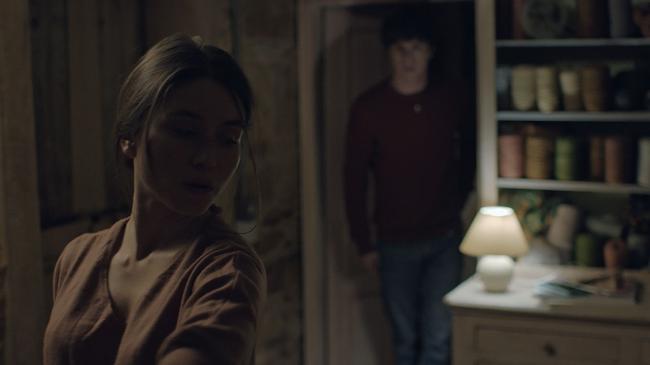
KC At times in your film, there is conspicuously no ambient sound. At other times, even though we see the characters talking, we don’t hear their dialogue or anything else. How did you decide when to use these moments? Do they always depend on Valmira’s presence on the screen?
MD The elliptical sound has been used as a way to express different “angles” in the scene. So what we tried to do is to give a sense of change of angle without moving the camera, but by altering the level of the sound. Of course it mostly depends on Valmira’s presence as it reflects her inability to hear. Generally, we tried to convey hearing impairment by using silence, sound fx, and music.
With composer Anna Stereopoulou—who typically mixes electronic music and classical—we experimented with various musical themes and frequencies. Anna wrote the original soundtrack, but she also designed a number of soundscapes (like the one we used when Valmira first hears through her hearing aid). Sound design took a long time since we had to mix music, sync sound, and all the other sound elements in a meaningful and aesthetically coherent way.
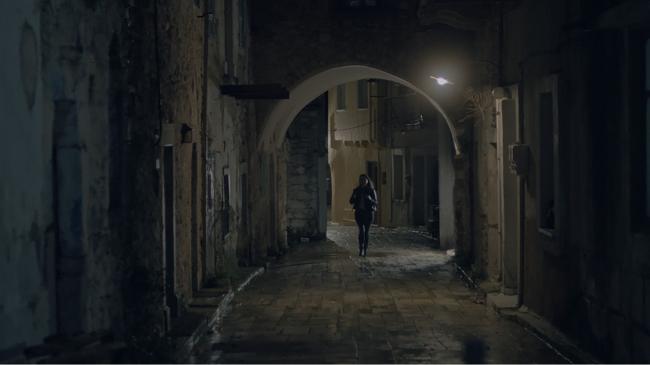
KC Voyeurism—which need not be sexual—can be considered the act of gaining pleasure (or advantage) from privately watching others’ pain or distress or intimacy. A voyeur could be a “peeping Tom” on someone else in a vulnerable situation. It’s a way of visually spying on someone while remaining incognito. In our digital world today, we almost take for granted secret invasions of our privacy, forgetting that voyeurism has long been employed as a cornerstone of cinema, allowing audiences to “invade” (without recognition) the special or intimate or tortured moments of others through the camera “keyhole.” Both the composition of images within the frame and the editing of a film sequence are used to enhance this thrill. Do you think films often apply this same strategy via sound? Do you have any examples?
MD Off screen sound is a fantastic medium for bringing in the story information or building feeling. Deliberate or accidental eavesdropping has been used extensively in movies to reveal secrets, essential information, clues, and to take the story forward. It can also work as counterpoint, to create contrast between the environment and what the character feels—i.e., hearing happy music while the character is in distress. It can be used to cover sync sound and block important information from being heard at critical moments.
In Listen we could not do this easily, since the main character is deaf. So there is little use of off-screen sound. (An example is the scene when Stamos bangs on the closed door while Aris and Valmira fight. This is interesting because Aris can hear the banging but Valmira can’t.) But there are a couple of moments in Listen when eavesdropping is deliberate and important.
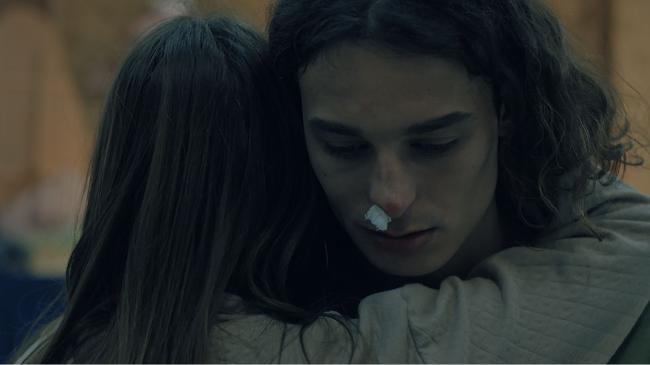
KC Both Valmira and Aris at times enact what could be called, for lack of a better term, “aural voyeurism.” At a key moment, Aris eavesdrops on a conversation with the school’s Headmistress regarding a letter from Marios. At least twice, this “aural voyeurism” is mediated by auditory devices: Valmira monitors Stamos’ dialogue with the villagers with her hidden hearing aid, and Aris forces the insults of his classmates to be overheard by the administration by turning up a microphone system. Did you want to draw our attention to the capacities and the power of the ear—maybe to the role it can play in cinema—or just to move your story along in an exciting way?
MD This “aural voyeurism,” as you put it, is employed in the film for narrative purposes but also because it is linked to the theme of the film, which is the act of listening. So while it advances the story, it also expresses the subject matter, tying them together.
KC In many cases, the methods of communication in Listen depend on the generation of those participating. Valmira uses text messages on her phone, and Facebook (or Skype or Zoom?) to converse with her girlfriend in Athens, who is also deaf, so they sign. Aris learns to sign right away, to get closer to Valmira. But Marios doesn’t. How do Marios and Valmira communicate? Are their joint soccer victories enough? (Team sports, after all, can be a culture and a language, and the game welcomes Valmira but shuts out Aris!) Is a sigh, a smile, and a kiss enough? There is a kinesthetic mutual attraction between Valmira and Marios, but is its heartbeat facilitated by something Marios knows that no one else knows?
MD Communication can indeed happen in many ways, but in all cases, it requires effort. Regarding listening, Cambridge Dictionary makes the following distinction: “‘Hearing’ is… something which happens to us…. ‘Listening’ is an action; it is something we do consciously.” This is the idea behind the story of Valmira. Whether by cultivating a skill one already has (like dance and sports) or by learning a language (as Aris does), understanding requires effort. Listening is a prerequisite for understanding, and understanding is a prerequisite for accepting. But where language and all else fail, there remains one thing that can still let us understand each other: this is compassion, our natural tendency for empathy.
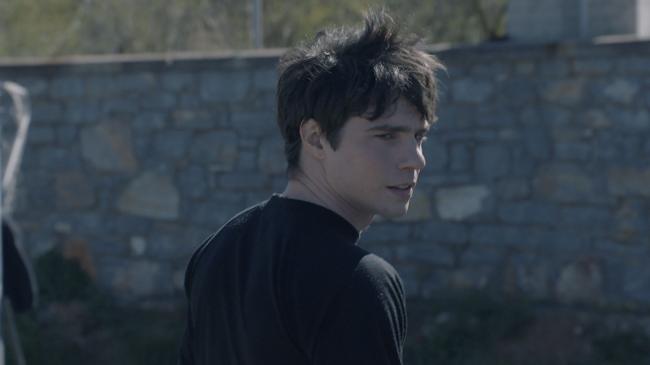
KC Do Marios and Valmira communicate what they need to say through dance? After all, dance seems to be a language of its own in your film. If “language” is any system of expression or communication that succeeds by a common understanding of shared values and symbols, what does the circle dance mean to the girls? To the boys? Do non-Greeks appreciate the cultural value of this dance in communication? Valmira also dances by herself, in front of the mirror, and wants to study dance. Does it mean something beyond cultural expression for her—perhaps self-dialogue?
MD Dance in the film is important as it serves multiple purposes and is connected to the theme. As you say, dance is—in a way—yet another system of communication between people, through which they share their communal values and traditions. It is a “body language,” a physical way to express oneself and a very important one for a deaf person who uses her body (hands) to talk and “hear.”
Dance is an art that connects people, but I think that above all, the particular circular dance is a metaphor for togetherness, belonging, and inclusion. A cyclical dance where people hold hands suggests—I hope—the ultimate point the film wants to make. That for our common troubles and for the challenges humanity faces, the way to confront them should not be individualistic but communal. We cannot solve problems separately, but together.
KC Part of what’s special about your film is the subtle, quiet way that you let us enter the inner worlds of the characters without our ever thinking about it. Aris learns to sign out of love, Marios feels empathy pains as his gang taunts Valmira, and she herself gazes at beautiful drawings and she dances in solitude. Is this your way of showing us the complicated spurts of growth in coming of age?
MD Thank you very much for saying this. I do indeed try to tell the story in an indirect way—not through dialogue and too much plot, but rather through images and situations in which the characters’ idiosyncrasies are revealed. Part of the reason I made this film, besides its theme, was an attempt to tell a story with as little dialogue as possible, relying on the purely cinematic means of image (camera movement and framing), sound, and editing. This is actually how the idea for a deaf protagonist was born. I did not intend to make a film about deafness, but a film that would not need many words.
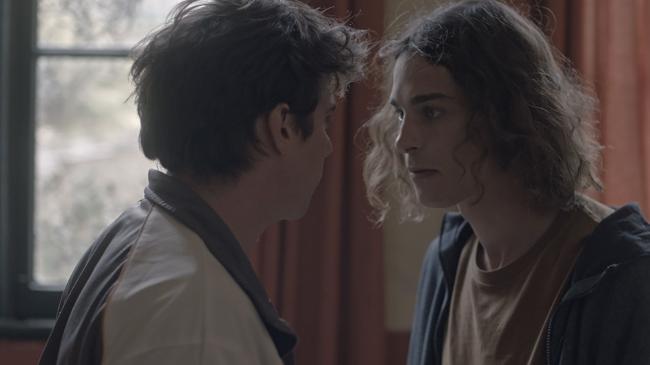
KC Is Valmira culturally prejudiced against Aris and his mother, or just resenting Aris’ “macho” protection and disruption of her romance, or just acting out a sibling—even step-sibling—rivalry? Does she think Aris is jealous of her because she “fits in”? Isn’t he jealous of Marios, due to her attraction to him? How did you decide to have her lie about Aris’ behavior with Marios?
MD Valmira is an educated and cultured girl, who grew up in the protected environment of the School for the Deaf. She is self-confident and never perceived herself as disabled; to her, her deafness is not a handicap; it’s who she is. Coming now to this small community, she does not want to be seen as “different”—and this is the reason that she distances herself from Aris. Aris is evidently an outsider (not only because he is bullied, but also because of his own different attitude toward life); therefore, she does not want to be associated with him.
She thinks that Aris is jealous of her because she succeeded where he failed, but what she does not realize is that because of her impairment, she misinterprets people and reality. Valmira has no idea that Marios is xenophobic and bullying, and when she reports at the school that he was hit by Aris, it is, again, because she does not really know what was said between the boys. Her refusal to wear her hearing aid and to try to adapt leads her to a series of misunderstandings and unjust actions—until she realizes that she, too, has to make an effort to reach out to other people, to “listen” and to comprehend them.
KC Aris and Valmira both struggle in a “blended family” just as their parents do, but there is also the xenophobia, hostility, and violence of the community, for parents and children alike. Have you observed these problems to be more universal than Greek?
MD I absolutely think the theme is universal and perennial. I think that fear of the other, ignorance, indifference, intolerance can be found in every society, at any time. They are not characteristics of our times. The difference today is that we address these issues vigorously and we confront them. This is why I did not want my film to be time- and place-specific, to but maintain an abstraction that would render it more universal.
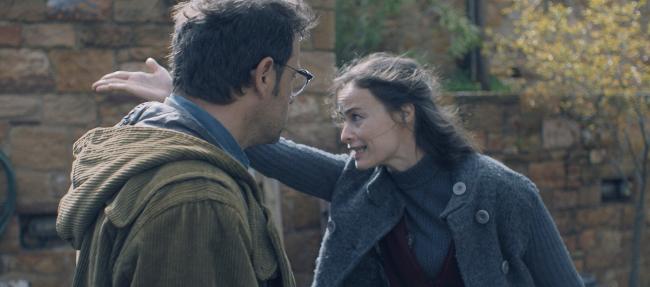
KC Can you comment on the two separate scenes with the aquarium? Is it a leitmotif in the film? How does the hearing aid end up there, and what does that mean?
MD The aquarium is Aris’ space, his hobby, showing his interests and sensitivities. This is how it entered the script and the film in the first place. I wanted Aris to have his own interests—very different from those of his peer—and since this is an island, I thought he might have an interest in sea creatures. So my initial idea about the octopus belonged to Aris’ interests. But then I realized that as images, both the aquarium and the octopus could symbolize ideas relevant to the theme of the film, so I used them more.
I would like, here, to clarify something. Sometimes, when we write a script, an image is born in our minds without us knowing why and how, and we are unaware that it has a deeper connection to our subject. I tend to trust these images and try to make use of them even without fully analysing their meanings, because I believe they have surfaced from somewhere deep inside me and they carry an important value. I can attempt some explanations, but these came after I made the film. The aquarium is a place where sound is eliminated, a silent environment, which perhaps reflects Valmira’s decision to remain deaf. The octopus, on the other hand, with its eight legs, probably reflects the many strands of the theme: isolation, exclusion, fear, etc., or indeed the fact that the theme is reflected in many characters. I say perhaps because this was not intentional.
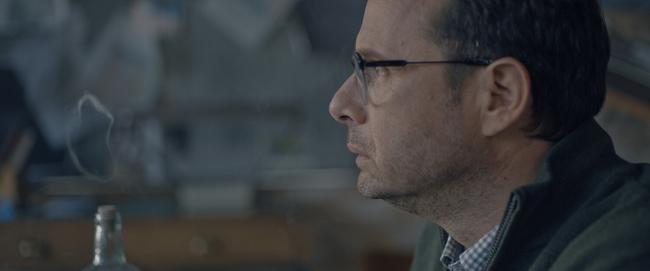
KC Does anyone besides Stamos know about the bullying of Aris?
MD Stamos and Tanya know that Aris has a hard time at school and in the community, but not the extent of this. They suspect rather than know.
KC Why does Stamos fail to communicate, not only with his stepson Aris but also with his wife Tanya?
MD Stamos is a man suffering from unresolved grief for his wife’s death, and therefore some form of depression. This is why his interactions with the people around him, close and distant, are difficult and flawed. Tanya is his support system - but he lets her down by not controlling Valmira’s actions. The idea here again was to link all characters to the main theme, of the difficulty to communicate, to listen, and to be heard.
KC For that matter, is it Aris or Marios who is the first to “listen”?
MD Aris does not begin to listen during the film. He is a “listening” person from the beginning, in the sense that he “understands and empathizes” with others. Aris has a talent for compassion, so when his kindness and goodness are misunderstood, he feels a terrible sense of loss and betrayal. So, to answer your question, it is Marios who is the first to “listen” as he goes through the transforming emotions of love and fear—emotions that bring him, in the end, to a totally new place from where he started.
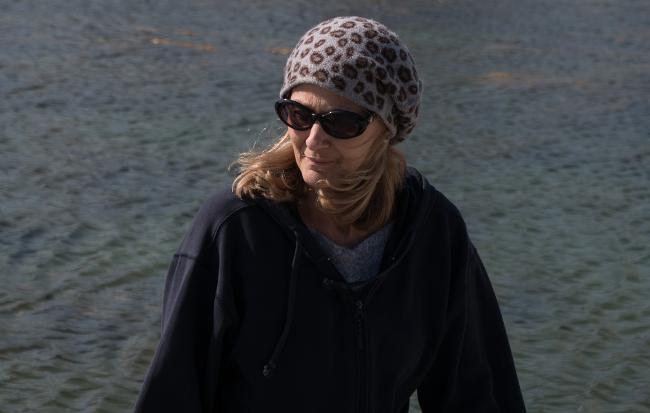
KC What could allow the “gang” to lose its hostility and accept Aris?
MD I think that on one hand, it is what Marios faces that makes all the boys in the gang drop their hostility, but also the fact that Marios changes.
KC The films that come to mind for me about characters who lose their hearing are fairly conventional Hollywood movies about real people—Helen Keller, Beethoven, Van Gogh. Is “listening” really about something else in your film? About understanding? Forgiveness? Redemption? How does your film language itself expand the notions we might hold regarding “listening” in cinema? Does your film challenge our viewing habits and our demands of the screen?
MD “Listen” is definitely not a film about deafness or disability. Deafness is a pretext to talk about emotional and psychological impairment, about our inability—or indeed our reluctance—to listen. We pretend to be open and tolerant, but we just have parallel monologues. We talk to express our views, but we do not listen actively to our interlocutors. We are keen to listen to and understand the distant “other,” but we find it hard to listen to the person next door.
Valmira’s deafness serves as a metaphor of both our need to hear and our choice not to hear; our desire to be heard but also our refusal to listen, our egotistic preoccupation with the self. Every character in the film seems like an island cut off and floating in the wide sea. In the end, what we want the audience to feel is that although deafness may be a handicap of the ear, in a metaphorical way it can be a handicap of the soul. And the only antidote to the deafness of the soul is empathy, the ability to become the other—to allow our natural tendency for compassion to overwhelm us.
Listen
Producers: Michael Sarantinos, Ivan Tonev; Director: Maria Douza; Screenwriter: Maria Douza; Cinematography: Zaphiris Epaminondas; Editor: Ioanna Pogiantzi; Music: Anna Stereopoulou.
Cast: Efthalia Papacosta, Dimitris Kitsos, Yorgos Pyrpasopoulos, Yoana Bukovska Davidova, Nikos Koukas, Vangelio Andreadaki.
108 min., Color, Widescreen. In Greek with English subtitles.